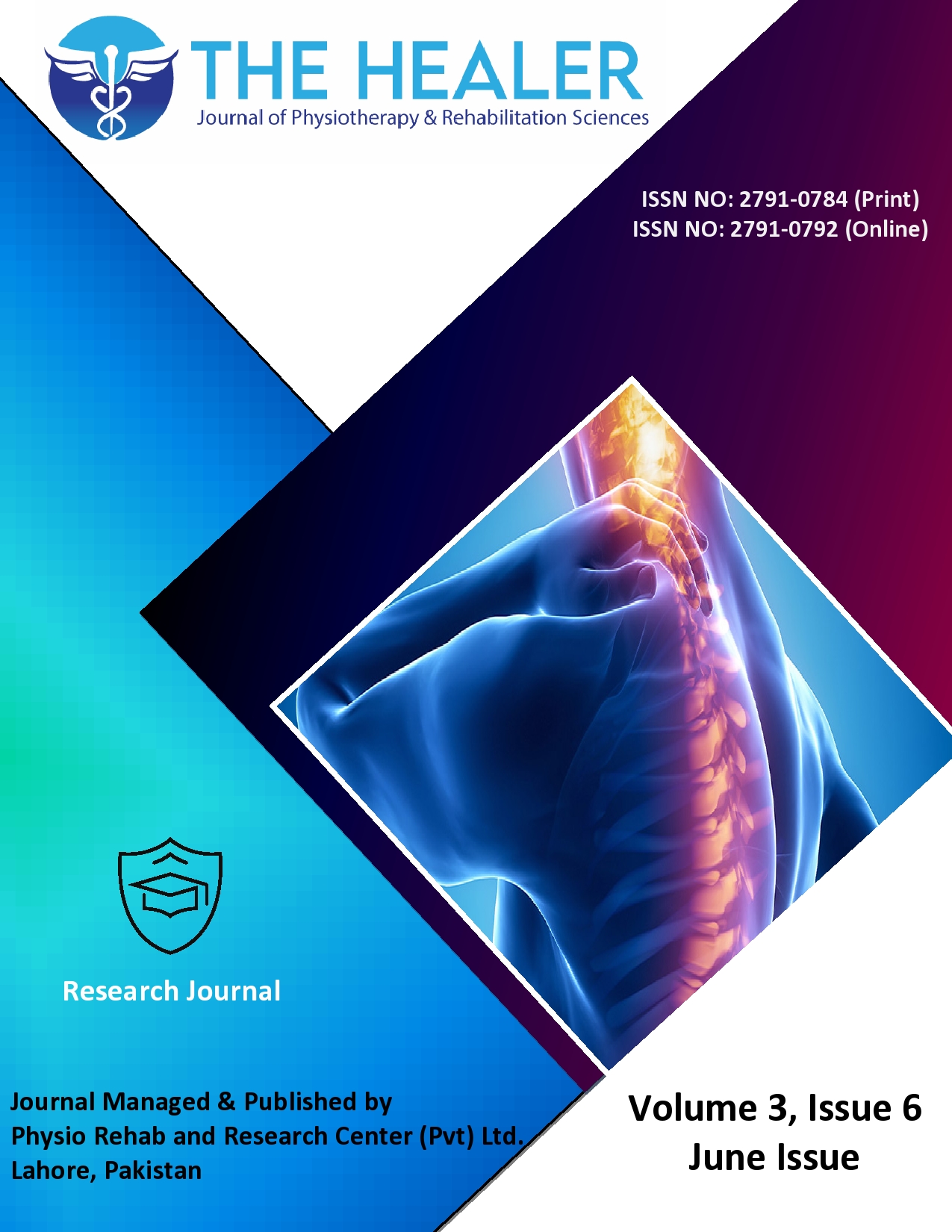Effectiveness of Pain Release Phenomenon in Chronic Cervical Pain
Pain Release Phenomenon in Cervical Pain
DOI:
https://doi.org/10.55735/hjprs.v3i6.163Keywords:
cervical pain, chronic neck pain, Mulligan pain release phenomenonAbstract
Background: Physical therapy intervention is the mainstay for treating chronic neck pain i.e. Non-specific. Despite the availability of several treatment options, there is a lack of agreement on any specific treatment approach for chronic cervical pain. Objective: To find the effectiveness of the Pain Release Phenomenon in chronic cervical pain for pain and finding how long those results were sustained by the patient. Methods: A quasi-experimental study with a total of 44 patients was conducted in Gulab Devi Hospital and Lifeline Hospital, Lahore for six months. Data was collected using a purposive sampling technique and patients with age between 25 to 45 years having chronic cervical pain for at least two months were included and subjects who had undergone any surgical procedure, having radiculopathy and systemic disease were excluded. After taking written consent from the participants, the pain intensity was measured by a numeric pain rating scale at baseline, then four sessions of pain release phenomenon were applied in a week and the readings were measured after two weeks follow up, then again four sessions were applied in next week and then readings were measured at follow up period after four weeks. The data were analyzed by using SPSS version v20. After assessing the normality by Shapiro Wilk test and Q-Q plot the data were normally distributed as the (p-value>0.05). The repeated measure analysis of variance test was used to analyze the data. The presentation of qualitative variables was in the form of frequency tables and percentages whereas quantitative variables were presented in the form of mean and standard deviation. Results: Patients did not differ in baseline pain and disability level initially. Two weeks and four weeks post-intervention receiving pain release phenomenon showed markedly improved functional status (p-value=0.00, confidence interval=95%) and reduction in the level of pain (p-value=0.00, confidence interval=95%). Conclusion: This study concluded that the Pain release phenomenon is an effective technique in the improvement of movement and function and also in reducing pain in patients having chronic cervical pain over a total of six weeks and the effects of the treatment last over a period given for follow-ups.
Downloads
References
Capo-Juan M. Cervical myofascial pain syndrome. Narrative review of physiotherapeutic treatment. Anales del sistema sanitario de Navarra; 2015; 2015. p. 105-15.
Cohen SP. Epidemiology, diagnosis, and treatment of neck pain. Mayo Clinic Proceedings; 2015: Elsevier; 2015. p. 284-99.
Gross AR, Goldsmith C, Hoving JL, et al. Conservative management of mechanical neck disorders: a systematic review. The Journal of rheumatology 2007; 34(5): 1083-102.
Farooq MN, Mohseni-Bandpei MA, Gilani SA, Ashfaq M, Mahmood Q. The effects of neck mobilization in patients with chronic neck pain: A randomized controlled trial. Journal of bodywork and movement therapies 2018; 22(1): 24-31.
Vernon H, Humphreys K, Hagino C. Chronic mechanical neck pain in adults treated by manual therapy: a systematic review of change scores in randomized clinical trials. Journal of Manipulative and Physiological Therapeutics 2007; 30(3): 215-27.
Lin Y-C, Lai C-H, Chang W-H, Tu L-W, Lin J-C, Chou S-W. Immediate effects of ischemic compression on neck function in patients with cervicogenic cephalic syndrome. Journal of Manipulative and Physiological Therapeutics 2012; 35(4): 301-7.
Shinde S, Rayjade A. Effect of Mulligan’s Pain Release Phenomenon on Pain and Strength in Chronic Lateral Epicondylitis.
McDowell JM, Johnson GM, Hetherington BH. Mulligan concept manual therapy: standardizing annotation. Manual therapy 2014; 19(5): 499-503.
Shahid S, Ahmed A, Ahmed U. Effectiveness of Routine Physical Therapy with and Without Pain Release Phenomenon in Patello-Femoral Pain Syndrome. Int J Sci Res 2016; 5(7): 1891-919.
Cagnie B, Danneels L, Van Tiggelen D, De Loose V, Cambier D. Individual and work related risk factors for neck pain among office workers: a cross sectional study. European Spine Journal 2007; 16(5): 679-86.
Hogg-Johnson S, Van Der Velde G, Carroll LJ, et al. The burden and determinants of neck pain in the general population. European Spine Journal 2008; 17(1): 39-51.
Bhosale N, Kanase SB, Bathia K. Effect of Mulligan's Pain Release Phenomenon with Kinesiotaping in Chronic Patellofemoral Osteoarthritis. Indian Journal of Public Health Research & Development 2019; 10(4).
Miller J, Gross A, D'Sylva J, et al. Manual therapy and exercise for neck pain: a systematic review. Manual therapy 2010; 15(4): 334-54.

Downloads
Published
License
Copyright (c) 2023 The Healer Journal of Physiotherapy and Rehabilitation Sciences

This work is licensed under a Creative Commons Attribution 4.0 International License.














